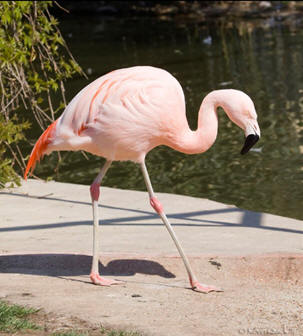What does the Chilean flamingo look like?
Phoenicopterus chilensis
have some well-known defining features. They have long legs and
neck. The adult birds are a light pink in color and they have
long curved bills (Wildlife Journal Junior 2014). Flamingos are
capable of walking/running on land, flying in the air and
swimming in water. For walking on land, they have two feet. For
flying they have a set of wings, feathers and hollow bones. For
swimming and wading in the mud, they have webbed feet. To access
food, the flamingos also uses its webbed feet to push into
sediments and dig up food sources and wait for the blue-green
algae, more specifically zooplankton or crustaceans, to float to
the top of the water for easy consumption (Flamingos-World
2014). They then use their bills to filter out larger particles
(Flamingos-World 2014)
Phoenicopterus chilensis are between four and five feet high and weigh around five to seven pounds (Wildlife Journal Junior 2014). When compared to other species of flamingos, the Chilean is smaller in size and paler in color than its relatives (Animal Diversity Web 2007). Chilean flamingos live in large flocks and it is their main defense mechanism against dangers (Animal Diversity Web 2007). When they are in large flocks they usually are very rambunctious and are capable of making loud honking noises, grunting and howling (Animal Diversity Web 2007).
Flamingos not only use their mouths
to make strange noises but their bills contain a complex, very
well adapted filter feeding system. In fact, flamingos are
considered to be the birds with the most highly developed filter
feeding systems (Kravetz and Mascitti 2001). When feeding, the
flamingo’s bill is held upside down (Kravetz and Mascitti 2001).
The water with food in it is swished back and forth and works as
a sieve (Wildlife Journal Junior 2014). They have two rows of
comb-like bristles (lamellae) on the inside of their beaks for
the purpose of filtering (Wildlife Journal Junior 2014). In
addition to the lamella, they also have about twenty small,
spiny bristles on their large, plump tongues to help with
filtering (Animal Diversity Web 2007). In addition to this, the
flamingos have a sort of mesh over a portion of their bills
(Kravetz and Mascitti 2001). This mesh helps with the inflow and
outflow of sediments and water
(Kravetz and Mascitti 2001). During the inflow of
water and food particles the mesh helps keep the too large of
particles out (Kravetz and Mascitti 2001). During the outflow,
the mesh helps to expel only water and keep the small food
particles in bill (Kravetz and Mascitti 2001).
The diet of the flamingos is what
causes their signature pink color. Specifically, this pale pink
color is due to their high intake of beta carotene
(Flamingos-World 2014). So, this means that when they are born
they are more dull colors, such as gray or white because they
have not yet consumed the beta carotene (Flamingos-World 2014).
As the flamingos age, they ingest more beta carotene and
gradually turn more pink in color (Flamingos-World 2014). It
takes approximately three years to fully develop the colorations
(Flamingos-World 2014). When in captivity,
it is almost impossible for the flamingos to eat exactly what
they do in the wild (Rosamond Gifford Zoo 2007). Therefore it is
hard for the flamingos to eat enough beta carotene to keep their
pink color. That is why often times the flamingos in captivity
are a duller color (Rosamond Gifford Zoo 2007). If the captors
want the flamingo to keeps its color, it must be fed a specially
formulated pink dye (Rosamond Gifford Zoo 2007).
When flamingos are been
scientifically studied it is somewhat challenging to determine
the sex of flamingos. There is a lack of external characteristic
to determine sex (Cassini et al. 2012). Sex of flamingos can be
determined by internal examination, but, that is often very
dangerous for the bird and sometimes results in death (Cassini
et al. 2012). So, instead certain size characteristics, such as
bill height/width and the size of the middle toe claw are used
to determine sex (Cassini et al. 2012). The male birds are
larger than the female birds (Cassini et al. 2012). This method
works well for wild flamingos however, they are not as accurate
when the flamingos are kept in zoos. Flamingos in zoos would
have to use the surgical internal examination method to ensure
accuracy (Cassini et al. 2012).
When flamingos sleep, they can choose to sleep laying down or standing up. When standing and sleeping, flamingos usually balance on one leg (Wildlife Journal Junior 2014).After a while, they shift their weight to the other leg and keep alternating until they are done resting (Flamingos-World 2014). It is believed by some that only a part of the flamingo’s brain sleeps at one time in order to keep their balance (Flamingos-World 2014).
Next, you will find out more about the reproduction styles of the Chilean Flamingo.
